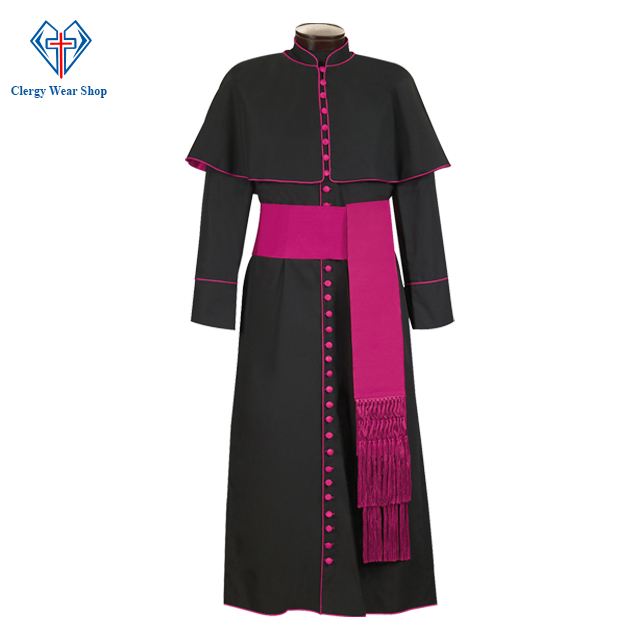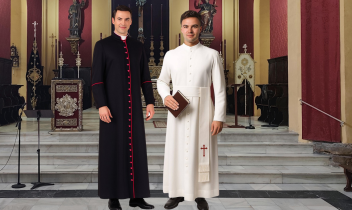No products in the cart.
Return To Shop
What is Cassock in the Catholic Church?
In the Catholic Church, cassock is a distinctive garment worn by the clergy, which has been in use for centuries. The cassock is not only a symbol of the clergy’s devotion to God but also a representation of their priestly office. In this article, we will explore the history and significance of the cassock in the Catholic Church, its variations, and how it is worn.
History of the Cassock
The cassock has its roots in ancient Rome, where it was a common attire for men. The garment was known as a “tunic” and was worn by people from all walks of life. In the 4th century, the Christian Church adopted the tunic as part of the vestments worn by the clergy. The tunic was then modified and transformed into the cassock, which became the official garment of the clergy.
Significance of the Cassock
The cassock is a symbol of the Catholic clergy’s devotion to God and their priestly office. It represents the priest’s commitment to serve God and his people. The cassock is also a reminder of the priest’s vow of poverty, as it is a simple garment that does not allow for personal expression or luxury.
Variations of the Cassock
There are several variations of the cassock, each with its own meaning and significance. The most common types of cassocks are:
Black Cassock
The black cassock is the most traditional type of cassock worn by the clergy. It is a long, black garment that reaches down to the ankles and is usually worn with a white clerical collar. The black color represents the priest’s commitment to self-discipline and self-denial.
White Cassock
The white cassock is worn by the Pope and bishops. It is a symbol of their high rank and authority within the Church. The white color represents purity, holiness, and the light of Christ.
Red Cassock
The red cassock is worn by Cardinals. The red color represents their willingness to shed their blood for the sake of Christ and his Church.
Purple Cassock
The purple cassock is worn by bishops and priests during the seasons of Advent and Lent. The purple color represents penance and preparation for the coming of Christ.
How is the Cassock Worn?
The cassock is worn over a white linen garment called an alb, which is a symbol of baptismal purity. The alb is worn with a cincture or rope around the waist, which symbolizes chastity and the priest’s vow of celibacy. The cassock is also worn with a zucchetto or skullcap, which is a symbol of the priest’s authority.
Conclusion
In conclusion, the cassock is a traditional garment worn by the Catholic clergy. It has its roots in ancient Rome and has been modified over the centuries to become the official garment of the clergy. The cassock represents the priest’s devotion to God and his priestly office, and there are several variations of the cassock, each with its own meaning and significance. The cassock is worn with other vestments that symbolize the priest’s commitment to serve God and his people.
FAQs
- Is the cassock only worn by Catholic clergy?
Yes, the cassock is a traditional garment worn by the Catholic clergy.
- What is the significance of the color of the cassock?
The color of the cassock represents different aspects of the priest’s commitment to God and his people.
- Can anyone wear a cassock?
No, only Catholic clergy are allowed to wear a cassock.
- Is the cassock still worn in modern times?
Yes, the cassock is still worn by many Catholic clergy today.
- How has the cassock evolved over time?
The cassock has undergone several changes over the centuries. Initially, it was a simple tunic worn by the clergy. However, as the Church grew in prominence, the cassock became more elaborate and was adorned with various accessories such as lace, buttons, and piping.
In the mid-20th century, there was a movement within the Church to simplify the vestments worn by the clergy, including the cassock. As a result, the cassock became plainer and more streamlined, with fewer accessories and decorations.
- Are there any rules regarding the wearing of the cassock?
Yes, there are certain rules and guidelines that govern the wearing of the cassock. For instance, the cassock should always be worn with a clerical collar, which is a white band worn around the neck. Also, the cassock should be buttoned up fully, except for the top button, which is left undone.
- What is the purpose of the cassock in modern times?
In modern times, the cassock still serves as a symbol of the clergy’s devotion to God and their priestly office. It is also a reminder of the priest’s vow of poverty and the need for self-discipline and self-denial.
Additionally, the cassock helps to identify the clergy in public and provides a sense of unity among the Church’s hierarchy.
- How is the cassock related to other vestments worn by the clergy?
The cassock is worn with other vestments such as the stole, chasuble, and dalmatic, which are all symbolic of the priest’s office and commitment to serve God and his people. These vestments are worn during Mass and other liturgical services and help to create a sense of solemnity and reverence.
In conclusion, the cassock is an important symbol of the Catholic clergy’s devotion to God and their priestly office. It has undergone several changes over the centuries and is now worn in a simplified form.
The cassock is worn with other vestments and serves as a reminder of the priest’s vow of poverty and the need for self-discipline and self-denial. Overall, the cassock plays a significant role in the Catholic Church and is an important part of the Church’s tradition and identity.








Add comment
You must be logged in to post a comment.